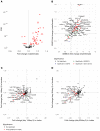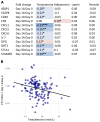BCG vaccination in humans inhibits systemic inflammation in a sex-dependent manner
- PMID: 32692728
- PMCID: PMC7524503
- DOI: 10.1172/JCI133935
BCG vaccination in humans inhibits systemic inflammation in a sex-dependent manner
Abstract
BACKGROUNDInduction of innate immune memory, also termed trained immunity, by the antituberculosis vaccine bacillus Calmette-Guérin (BCG) contributes to protection against heterologous infections. However, the overall impact of BCG vaccination on the inflammatory status of an individual is not known; while induction of trained immunity may suggest increased inflammation, BCG vaccination has been epidemiologically associated with a reduced incidence of inflammatory and allergic diseases.METHODSWe investigated the impact of BCG (BCG-Bulgaria, InterVax) vaccination on systemic inflammation in a cohort of 303 healthy volunteers, as well as the effect of the inflammatory status on the response to vaccination. A targeted proteome platform was used to measure circulating inflammatory proteins before and after BCG vaccination, while ex vivo Mycobacterium tuberculosis- and Staphylococcus aureus-induced cytokine responses in peripheral blood mononuclear cells were used to assess trained immunity.RESULTSWhile BCG vaccination enhanced cytokine responses to restimulation, it reduced systemic inflammation. This effect was validated in 3 smaller cohorts, and was much stronger in men than in women. In addition, baseline circulating inflammatory markers were associated with ex vivo cytokine responses (trained immunity) after BCG vaccination.CONCLUSIONThe capacity of BCG to enhance microbial responsiveness while dampening systemic inflammation should be further explored for potential therapeutic applications.FUNDINGNetherlands Organization for Scientific Research, European Research Council, and the Danish National Research Foundation.
Keywords: Cytokines; Immunology; Innate immunity; Monocytes; Vaccines.
Conflict of interest statement
Figures








Comment in
-
Antituberculosis BCG vaccination: more reasons for varying innate and adaptive immune responses.J Clin Invest. 2020 Oct 1;130(10):5121-5123. doi: 10.1172/JCI141317. J Clin Invest. 2020. PMID: 32813681 Free PMC article.
References
-
- Kaufmann E, et al. BCG educates hematopoietic stem cells to generate protective innate immunity against tuberculosis. Cell. 2018;172(1–2):176–190.e19. - PubMed

